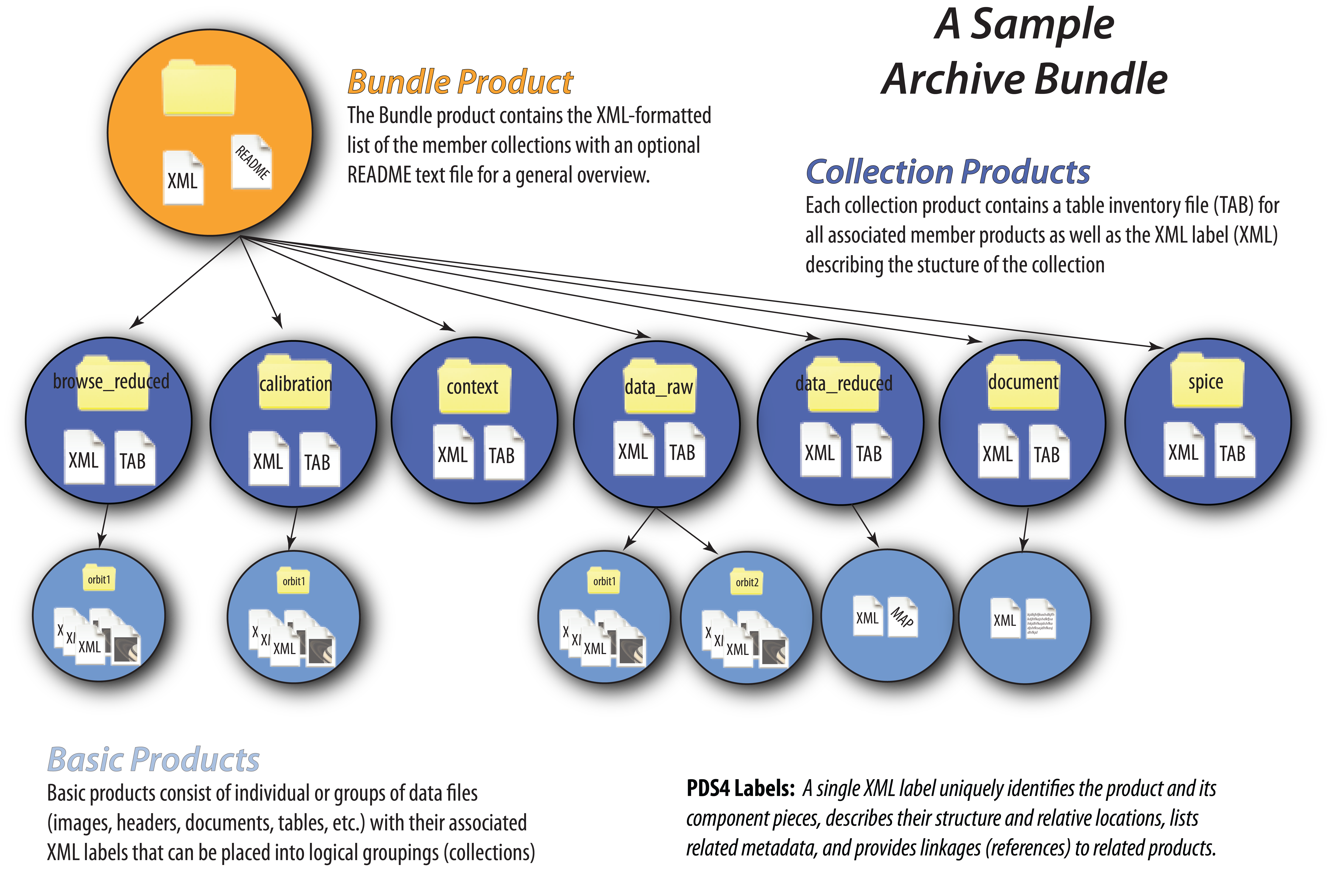Developing a Data Pipeline and PDS-Compliant Archive in Response to the New Frontiers Announcement of Opportunity (AO)
This document is meant to assist a proposer of a New Frontiers mission in sizing and costing the development of a science data system and the data archive. The major effort in developing this aspect of a proposal will involve considering the end-to-end processing of the mission data that Includes
- The formulation and testing of the data pipeline
- Identifying an approach for structural and scientific validation of the data
- Documentation of instrument calibration
- Preservation of information relating to the mission's observing log that is needed to support search and recovery from the archive as well as scientific use of the data.
New Frontiers missions will be required to create PDS4-compliant archives. This document provides a listing of factors to be included in estimating the cost of developing science operations and creating an archive.It includes a listing of contacts within PDS for technical advice while preparing a proposal, reference to a proposer's archiving guide and a brief explanation of PDS4 data structure.
Costing the Data Preparation, Validation and Archiving
The costs that will be incurred for preparation, validation and archiving of PDS4-compliant data will depend on several factors, including the complexity of the mission and the heritage of science operations and instruments. The following check list (Table 1) summarizes major factors to consider in developing and estimating the cost of creating a data archive for the Planetary Data System (PDS). These elements should be described in a Data Management and Archive Plan as part of a New Frontiers Proposal.
Table 1. Check List for Developing and Costing of a Data System
|
Check List for Developing and Costing of a Data System |
|
|
Science Operations Center (SOC) |
|
|
1. Distribution of data to and receipt of products from instrument teams |
|
|
2. An Archiving Working Group |
|
|
3. Document Development (mission data management plan, etc.) |
|
|
Individual Instrument Teams |
|
|
1. Definition of raw and processed data products |
|
|
2. Estimation of needed calibration activities |
|
|
3. Estimation the data volume and complexity |
|
|
4. Pipeline development |
|
|
5. Use of PDS4 validation software (available from the PDS) |
|
|
6. Scientific validation by team members using the data to be archived |
|
|
7. Development of archival documentation |
|
|
Interaction with the PDS |
|
|
1. Development and review of data plan and documentation |
|
|
2. Review of the design of pipeline products |
|
|
3. Establishment of a delivery schedule |
|
|
4. Peer review |
|
|
5. Lien resolution |
|
|
Staffing |
|
|
1. Estimation of adequate staffing for the SOC |
|
|
2. Estimation of required staffing for science teams to complete data development and archiving activities |
|
Contacting the Appropriate PDS Personnel
Each team is responsible for presenting a well-defined archive plan and accompanying budget. If needed, PDS staff members are available to provide technical advice. Contact the nodes that are most closely related to dealing with the products you will generate to meet your mission goals.
Table 2. PDS Personnel Who Can Provide Technical Advice
|
PDS Node * |
Personnel to contact |
|
Geosciences |
Ray Arvidson, arvidson@wunder.wustl.edu, 314-935-5609 |
|
Cartography and Imaging Sciences |
Lisa Gaddis, lgaddis@usgs.gov, 314-935-5609 |
|
Navigation and Ancillary Information Facility (NAIF) |
Chuck Acton, charles.acton@jpl.nasa.gov, 818-354-3869 |
|
Atmospheres |
Reta Beebe, rbeebe@nmsu.edu, 575-646-1938 |
|
Planetary Plasma Interactions |
Ray Walker, rwalker@igpp.ucla.edu, 310-825-7685 |
|
Ring-Moon Systems |
Mark Showalter, mshowalter@seti.org, 650-810-0234 |
|
Small Bodies |
Ludmilla Kolokolova, ludmilla@astro.umd.edu, 301-405-1539 |
|
PDS Program Manager |
Tom Morgan, thomas.h.morgan@nasa.gov, 301-286-1743 |
If you are selected for a Phase A study
During the Phase A period you should interact with the appropriate PDS node to refine your archiving plans and define a delivery schedule to allow a valid assessment of this component of your mission.
Basic Steps for Planning and Preparing a Dataset are:
- Gaining a preliminary understanding of a PDS4 data bundle
- Working with PDS nodes to design products and labels
- Creating archive products, collections and bundles
- Submitting products, collections and bundles to PDS
- Participating in peer reviews of the products, collections and bundles
The PDS4 System
The PDS has developed the PDS4 system to streamline the ingestion and distribution of archived data and to take advantage of the structured data capabilities and off-the-shelf software that is available with the Extensible Markup Language (XML). A useful resource, the Mission Proposer's Archiving Guide (MPAG), is available at https://pds.nasa.gov/documents/pag/Mission-Proposers-Archive-Guide-v4-r5.pdf
Contents of a PDS4 Data Bundle
Data in PDS4 are organized into a hierarchical structure of bundles, collections, and basic products. Bundles contain logical groupings of related collections and collections contain logical groupings of related basic products (See Figure 1.) Collections may include: context information (target, spacecraft, instrument, etc.), documentation for usage of the data, science data (raw, calibrated, derived), calibration information, and linkages to XML schema and schematron (blueprints and sets of rules) used in the generation of the label files. Development and construction of the labels is the key to constructing the mission bundles.
An example bundle can be found at http://atmos.nmsu.edu/PDS/data/PDS4/LADEE/nms_bundle/ The bundle consists of collections containing documentation and data with labels.
A supporting web page can be found at ( http://pds-atmospheres.nmsu.edu/data_and_services/atmospheres_data/LADEE/nms.html) providing an introduction as an alternative to the bare directory structures for ease of use for incoming users, highlighting more information about the mission, instrument, and resulting data.
If you have questions, seek help from your PDS contact (See Table 2).

Figure 1. Structure of a PDS4 Data Bundle
 PDS: The Planetary Data System
PDS: The Planetary Data System
